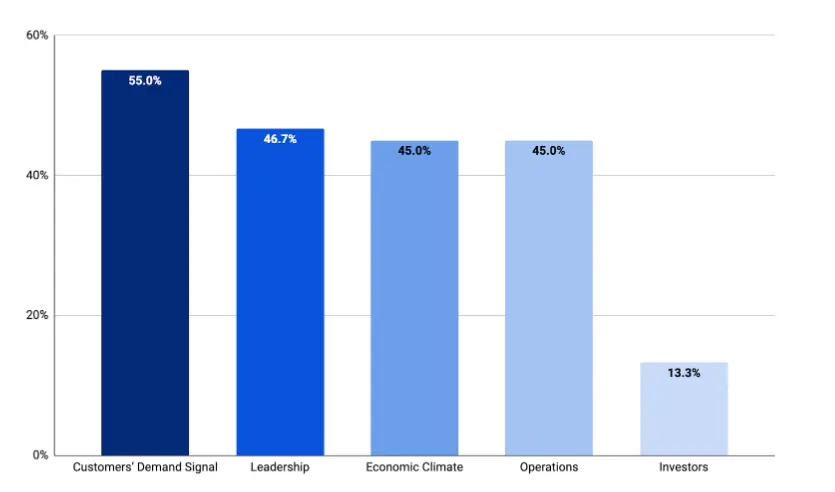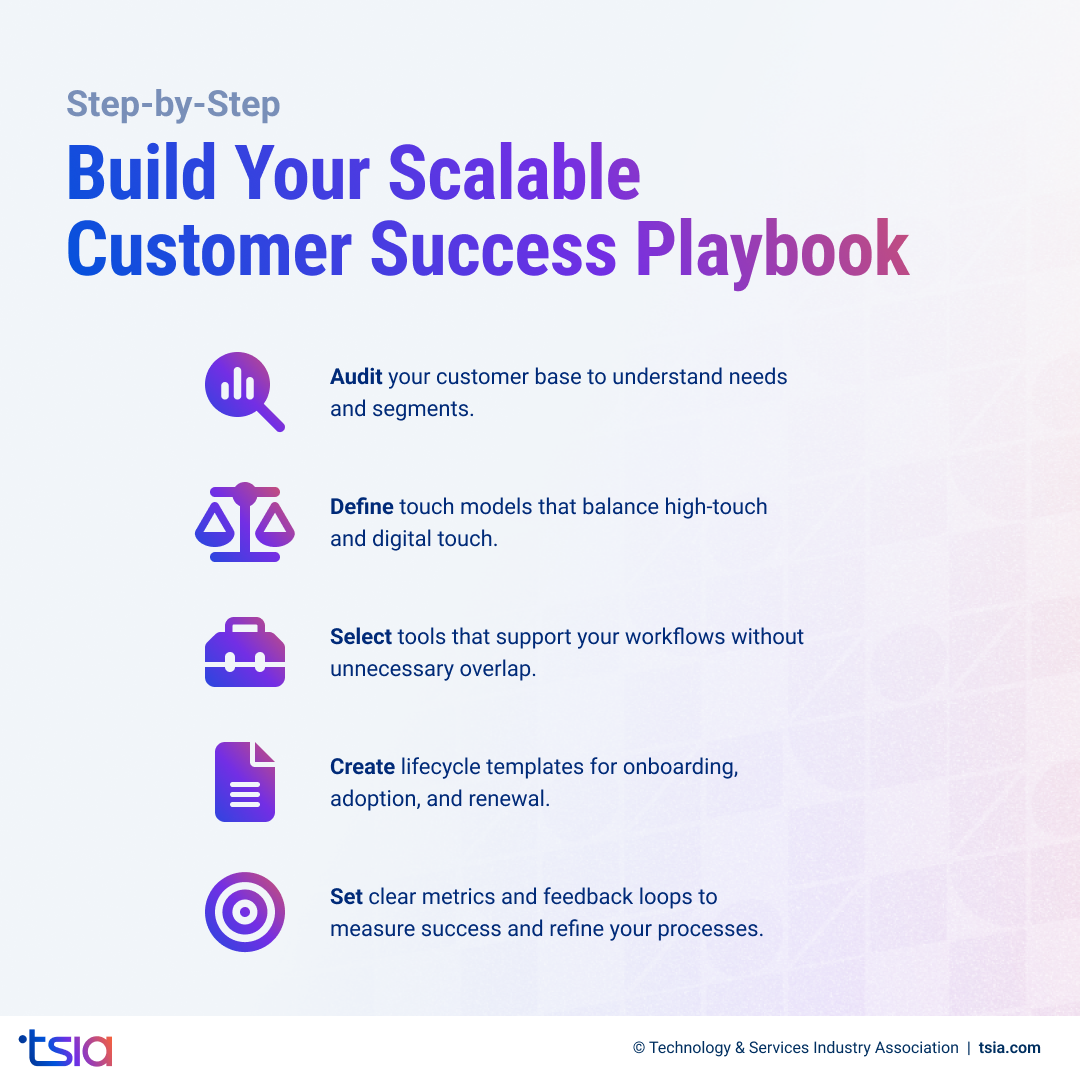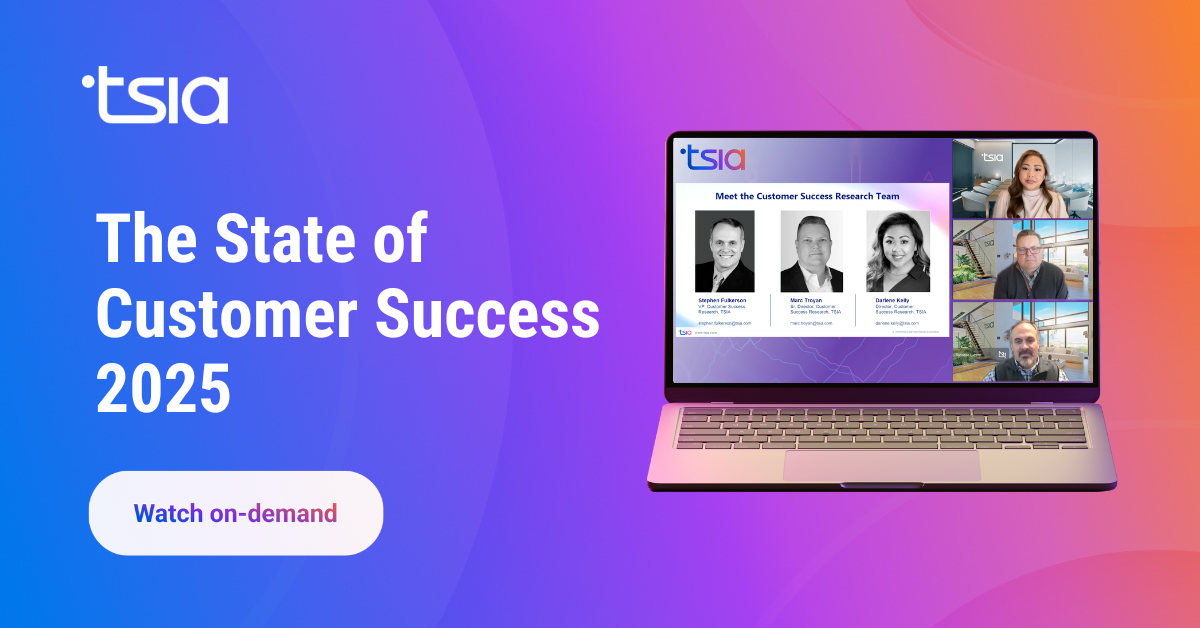Customer success (CS) has quickly become one of the most critical drivers of growth in B2B businesses. However, as your company grows, the challenge of maintaining effective and profitable customer success efforts does too. The reality is, that what works for a small team of customer success managers won’t always work when you’re serving hundreds—or even thousands—of accounts.
Scaling customer success isn’t about throwing more people at the problem. It’s about building strategies, processes, and systems that allow you to deliver value consistently while protecting your margins.
Key Takeaways
- Scaling customer success requires more than just hiring additional customer success managers (CSMs)—it’s about optimizing efficiency, leveraging automation, and implementing innovative processes.
- Both internal strategies (like segmentation, playbooks, and tech stack decisions) and external factors (like customer demand and leadership priorities) shape how you scale.
- Successful scaling balances growth with sustainability, ensuring you deliver value without overwhelming your teams or draining resources.
Why Scaling Customer Success Matters
As customer expectations grow and the number of accounts you manage increases, scaling customer success becomes essential. Without scalable strategies, you risk higher churn, burned-out teams, and missed revenue opportunities.
Scaling ensures you can:
- Serve more customers without sacrificing the quality of their experience.
- Improve efficiency by aligning your processes, tools, and team structures.
- Drive long-term profitability by focusing on outcomes instead of reacting to issues.
When strategically approached, scaling helps you keep pace with demand while strengthening your foundation for future growth.
Related: Scaling Customer Success with Data and Insights
Common Challenges When Scaling Customer Success
Scaling customer success comes with hurdles, and recognizing them early helps you avoid costly missteps:
- Limited headcount: Many companies default to hiring more customer success managers, but this quickly becomes expensive and inefficient.
- Unclear segmentation: Without clear customer tiers, teams struggle to balance high-touch and tech-touch engagements.
- Technology sprawl: Overlapping tools and disconnected data make it more complicated to deliver a consistent customer journey.
If you’ve felt these growing pains, you’re not alone. The good news is that you can overcome them by focusing on the right pillars of scale.
Related: Perceptions of Scaling in Customer Success
External Factors That Influence Scaling Customer Success
Scaling customer success isn’t only about what you do internally with processes, people, and tools. External factors also shape how quickly and effectively you can grow. In our research, companies pointed to several outside influences that create pressure to scale:
- Customer demand: The strongest driver comes directly from your customers. As they request more support, localized engagement, or digital self-service options, you must adapt your customer success strategy to keep pace with their evolving needs.
- Leadership priorities: Executives set the tone for how resources are allocated and utilized. Without clear direction and sponsorship from leadership, scaling efforts often come to a halt.
- Operational constraints: Day-to-day execution challenges, such as limited workflows or disconnected systems, can hinder your ability to expand and grow.
- Economic climate: Market conditions shape how aggressively companies can invest in customer success. During uncertain times, efficiency often takes priority over headcount.
- Investor expectations: Smaller companies, in particular, may feel pressure from investors to demonstrate that scaling customer success directly contributes to growth and profitability.
By paying attention to these external signals, you can prioritize the right areas of investment and avoid reacting in ways that overextend your team.

What are the environmental circumstances that are encouraging the scale of customer success?
Key Pillars of a Scalable Customer Success Model
There’s no single way to scale customer success. However, successful organizations share four core pillars.
Segmentation & Playbooks
- Define clear customer tiers (high-touch, low-touch, digital-led).
- Build playbooks for each segment that outline specific actions, from onboarding to renewal, to ensure seamless customer experiences.
- Operationalize your customer journey maps so that every stage is consistent and repeatable.
Automation & Tech Stack
- Invest in customer success platforms that help you centralize data and automate workflows to streamline your operations and enhance customer satisfaction.
- Automate everyday tasks like email touchpoints, quarterly business reviews (QBRs), and Net Promoter Score (NPS) surveys.
- Utilize integrations to connect customer success tools with customer relationship management (CRM), support, and product data, providing a comprehensive view of your customers.
Team Structure & Roles
- Evolve from generalist customer success managers to specialized roles like Onboarding Specialists, Renewal Managers, and Customer Marketing leads.
- Specialization reduces inefficiencies and enables each role to focus on its area of expertise.
- Consider how your organizational structure may need to adapt as your customer base grows.
Customer Health Metrics
- Track key signals, such as product usage, renewal likelihood, and sentiment scores.
- Utilize customer health scorecards to identify potential risks and proactively uncover opportunities for upselling.
- Regularly revisit KPIs to ensure they reflect current business goals.
Related: Scaling Customer Success
Build Your Scalable Customer Success Playbook: Step-by-Step
Here’s a simple framework you can adapt to your business:
- Audit your customer base to understand needs and segments.
- Define touch models that balance high-touch and digital-touch.
- Select tools that support your workflows without unnecessary overlap.
- Create lifecycle templates for onboarding, adoption, and renewal.
- Set clear metrics and feedback loops to measure success and refine your processes.

When To Scale and When To Optimize
Not every customer success team needs to scale right away. In some cases, refining your processes or improving segmentation has a bigger impact than expanding your headcount.
Ask yourself:
- Do we have the right workflows and tools in place today?
- Are we using automation where possible?
- Could efficiency improve with better segmentation or role specialization?
Sometimes, optimization is the smarter, first step before making significant investments in scale.
Focus on Value, Not Just Volume
Scaling customer success is about delivering value in more innovative, sustainable ways. If you rely only on hiring, you’ll quickly hit diminishing returns. By balancing people, processes, and technology, you can scale sustainably while keeping customers engaged and satisfied. Focusing on efficiency and value ensures that your customer success strategy evolves in tandem with your business.

Frequently Asked Questions
What are the best strategies for scaling customer success?
The best strategies focus on efficiency and consistency. Start by segmenting your customer base into high-touch and digital-touch models, build playbooks for each segment, and utilize automation to handle repetitive tasks, such as check-ins and surveys. Investing in the right customer success platforms and evolving your team roles over time ensures you can scale without sacrificing quality.
How do you scale customer success with limited resources?
If you’re working with a small team or budget, prioritize processes and automation first. Standardize onboarding and adoption playbooks, leverage automation tools to handle repetitive communication, and employ a tiered approach that prioritizes high-value accounts for more attention while still providing support to smaller accounts. This ensures growth without overextending your team.
How does TSIA help with scaling customer success?
TSIA provides data-backed insights, frameworks, and best practices to help you scale efficiently and effectively. With access to benchmarks and research, you can make informed decisions tailored to your company's size and maturity.
Smart Tip: Embrace Data-Driven Decision Making
Making smart, informed decisions is more crucial than ever. Leveraging TSIA’s in-depth insights and data-driven frameworks can help you navigate industry shifts confidently. Remember, in a world driven by artificial intelligence and digital transformation, the key to sustained success lies in making strategic decisions informed by reliable data, ensuring your role as a leader in your industry.














